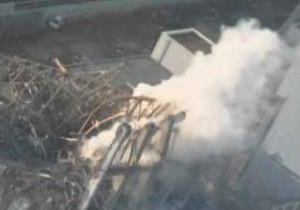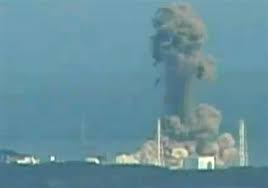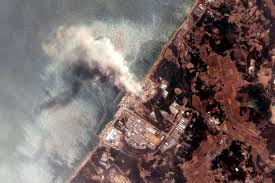http://www.asyura2.com/14/genpatu39/msg/259.html
| Tweet |


Gov’t Report: Criticality suspected to have occurred in Fukushima fuel pool — Nuclear chain reaction after massive explosion at Unit 3 compressed fuel together? Concerned about ‘substantial damage’ to fuel (VIDEO)
政府レポート:3号機の大規模爆発が燃料同士を互いに圧縮させた後に核連鎖反応?−臨界が福島燃料プールで発生したと疑われる 燃料に対する「実質的な損傷」を懸念(映像)
Published: July 4th, 2014 at 6:11 pm ET By ENENews
公開:2014年 7月4日、午後6:11 ET ENENewsによる
Fukushima Daiichi Accident 3 years after, Canadian Nuclear Safety Commission, Ramzi Jammal, Executive Vice-President and Chief Regulatory Operations Officer of the Regulatory Operations Branch, Physics Colloquium at Queen’s University, March 14, 2014:
3年後の福島第一事故、カナダ原子力安全委員会、ラムジ・ジャマル、最高幹部副総裁・規制業務支局の規制業務主任指揮官、クイーンズ大学物理学学術会での講演(コロキウム)、2014年3月14日:
Smoke from SFP at Unit 3? Quote from [The National Diet of Japan's report 'Fukushima Nuclear Accident Independent Investigation Commission'] What was the source of the massive amount of heat that caused intermittent water evaporation in the form of white smoke to come out of the pool? If the pool was impacted from the hydrogen explosion, it is probably that the used and unspent fuel assemblies were moved closer together and became compressed against one another, creating a condition of criticality [uncontrolled nuclear chain reaction] inside the pool.
3号機の使用済核燃料プール(SFP)の煙? [日本国会の報告書「福島原発事故独立調査委員会」] から引用。プールから出てくる白煙の形で、断続的な水の蒸発を引き起こした大量な熱の源は何でしたか?もしプールが水素爆発の影響を受けたならば、おそらく、その使用済および未使用燃料集合体が互いに接近するように移動し、互いに圧縮し合い、プール内部で臨界[制御されない核分裂連鎖反応]の条件を生み出した。
Comment in the Canadian Nuclear Safety Commission’s presentation: Based on the result of criticality assessment [...] there are no criticality in SFP.
カナダ原子力安全委員会の発表でのコメント:臨界を評価した結果に基づいて[...]使用済核燃料プール(SFP)に臨界はありません。
Fukushima Nuclear Accident Independent Investigation Commission, National Diet of Japan (emphasis added): Hydrogen explosion of Unit 3 and heat source within the spent fuel pool. The hydrogen explosion resulted in a plume of white smoke immediately after the explosion, and on the two following days. Observation of the spent fuel pool after the explosion shows the possibility of substantial damage to the fuel. But the dumping of a large amount of water after the explosion might have kept the radioactive material in the pool to be within or around the building, reducing the further spread of radioactive material. It is also possible that rainfall could have caused part of the radioactive material to fall into the ocean. [...]
福島原発事故独立調査委員会、日本の国会(強調は記者による):3号機の水素爆発や使用済み燃料プール内の熱源。水素爆発は爆発した後直ちに白煙プルームを引き起こした、そして次の2日間も続いた。爆発後の使用済み燃料プールの観察は、燃料に相当な損傷がある可能性を示しています。しかし、爆発後の大量の水の投入は、放射性物質のさらなる拡散を低減し、プール内の放射性物質を建造物内や周辺に保持した可能性があります。降雨は放射性物質の一部が海洋へ降り注ぐ原因となった可能性もある。 [...]
What was the source of the massive amount of heat that caused intermittent water evaporation in the form of white smoke to come out of the pool? The white smoke was generated not only immediately after the hydrogen explosion but on both of the next two days. There was, therefore, the possibility of damaged fuel inside the pool causing temporary massive heat generation.
プールから出てくる白煙の形態であり、断続的な水蒸発を伴う大量の熱源は何でしたか?白煙は水素爆発の後直ちにだけでなく、次の2日間両日も発生していました。それゆえに、プール内部の損傷した燃料が、一時的な大量の熱を発生させる原因となった可能性がありました。
The layout at the Unit 3 spent fuel pool shows that; 1) fifty-two of the unspent fuel assemblies were arranged together in almost one lump, while the surrounding racks were empty, and 2) nearly half of the spent fuel was arranged together in one lump. Therefore, if the pool was impacted from the hydrogen explosion, it is probable that the used and unspent fuel assemblies were moved closer together and became compressed against one another, creating a condition of criticality inside the pool.
3号機の使用済燃料プールのレイアウトがそれを示しています。1)52体の未使用燃料集合体は、ほぼ一塊(かたま)りで一緒に配置されていた、一方周囲のラック(棚)は空だった、そして2)使用済燃料のほぼ半分が一塊(かたま)りで一緒に配置されていた。それ故に、プールが水素爆発から影響を受けた場合には、使用済および未使用核燃料集合体は互いに近づくように移動し、プール内部に臨界条件を引き起こし、互いに圧縮し合った可能性が高いです。

Recall this BBC report from March 24, 2011: “Kyodo News [reports] neutron radiation was observed more than a kilometre from reactor buildings [...] Neutrons are emitted during a nuclear chain reaction; so given the context, is Kyodo’s report to be taken as indicating that a chain reaction took place after the reactors shut down? If it is, does that relate to the company’s warning last week that there was a possibility of “re-criticality” in a pool storing fuel rods?”
2011年3月24日、このBBCの報道を思い起こしてください。「共同通信は、中性子線は原子炉建屋から1キロ以上で観察されたと[報道した] [...]中性子は核分裂連鎖反応の際に放出される;その文脈を考えると、共同通信の報道は、原子炉が停止した後に連鎖反応が起こったことを示すと解釈されるべきである?もしそうであれば、そのことは、貯蔵プールの燃料棒が『再臨界』した可能性がある、という先週の同社の警告に関連するものでしょうか? 」
Watch — Gundersen: Unit 3 started as a hydrogen explosion… but I think it’s more — I actually think it was something called a prompt moderated criticality that was caused by a hydrogen explosion
注目−ガンダーセン:3号機は水素爆発として始まった...しかし私はそれ以上の事だと考える−私は実際にそれが水素爆発によって引き起こされた即発緩和臨界と呼ばれるものだったと考える

|
|
|
|
▲上へ ★阿修羅♪ > 原発・フッ素39掲示板 次へ 前へ
|
|
 スパムメールの中から見つけ出すためにメールのタイトルには必ず「阿修羅さんへ」と記述してください。
スパムメールの中から見つけ出すためにメールのタイトルには必ず「阿修羅さんへ」と記述してください。すべてのページの引用、転載、リンクを許可します。確認メールは不要です。引用元リンクを表示してください。